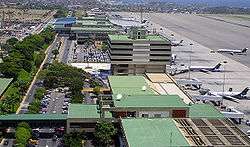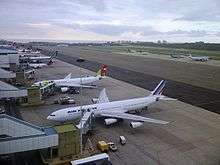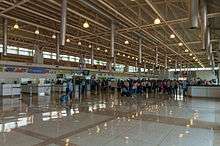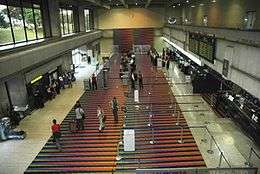Simón Bolívar International Airport (Venezuela)
| Maiquetía "Simón Bolívar" International Airport Aeropuerto Internacional de Maiquetía "Simón Bolívar" | |||||||||||||||
|---|---|---|---|---|---|---|---|---|---|---|---|---|---|---|---|
 | |||||||||||||||
| Summary | |||||||||||||||
| Airport type | Public | ||||||||||||||
| Owner/Operator | Instituto Autónomo del Aeropuerto Internacional de Maiquetía | ||||||||||||||
| Serves | Caracas, Venezuela | ||||||||||||||
| Location | Maiquetía | ||||||||||||||
| Hub for |
| ||||||||||||||
| Elevation AMSL | 235 ft / 72 m | ||||||||||||||
| Coordinates | 10°36′11″N 066°59′26″W / 10.60306°N 66.99056°WCoordinates: 10°36′11″N 066°59′26″W / 10.60306°N 66.99056°W | ||||||||||||||
| Website | aeropuerto-maiquetia.com.ve | ||||||||||||||
| Map | |||||||||||||||
 SVMI Location of airport in Venezuela | |||||||||||||||
| Runways | |||||||||||||||
| |||||||||||||||
| Statistics (2015) | |||||||||||||||
| |||||||||||||||
Simón Bolívar International Airport or Maiquetía "Simón Bolívar" International Airport (IATA: CCS, ICAO: SVMI, Spanish: Aeropuerto Internacional de Maiquetia "Simón Bolívar")[1] is an international airport located in Maiquetía, Vargas, Venezuela about 21 kilometres (13 mi) from downtown Caracas, the capital of the country. Simply called Maiquetía by the local population, it is the main international air passenger gateway to Venezuela among the twelve international airports in the country. It handles flights to major destinations in the Americas, the Caribbean and some in Europe.
History
The airport opened in 1945 as the Aeropuerto Internacional de Maiquetía.[2] The site had been recommended as an appropriate location for an airport by Charles Lindbergh on behalf of Pan Am. [3] The USA subsidized the construction of the airport as part of the Airport Development Program. Luis Malaussena was the architect who designed the original passenger terminal. [4]
It was regularly visited by the Anglo-French supersonic airliner Concorde until the 1980s. Commencing in the late 1970s, Air France operated weekly Concorde service between Caracas and Paris via a stop at Santa Maria Airport (Azores) located in the Atlantic Ocean.[5]
Between 1952 and 1962, two new wings were added to the passenger terminal, and the runway was expanded to 2000 m. Lighting was installed on the runway and approach zones to allow night operations. In 1956 a new runway was built, and in 1962, it was expanded to 3000 m long by 60 m wide.
In the 1970s a new international terminal was constructed to offer increased capacity with a domestic terminal opening in 1983. Since 2000, the airport has been undergoing major changes in order to meet international standards and to improve passenger traffic, security, immigration areas, and customs areas. Security measures have become top priority since the September 11 attacks, and now departure areas and arrival areas are completely split into the lower and upper levels of the airport. The Proyecto Maiquetía 2000 (Project Maiquetia 2000) was completed in 2007 which added new customs and immigrations areas, a new cargo terminal, and a connecting passageway between the domestic and national terminal.
As part of an expansion plan, new international gates are currently in construction, and a section of the parking area has been cleared to build an airport hotel. In the 1950s, under the regime of Marcos Pérez Jiménez, road transport between the airport and the capital was improved by the inauguration of the Caracas-La Guaira highway. However, the La Guaira and Caracas Railway, dating from the nineteenth century, was closed. In May 2007 a maglev train was proposed to link Caracas to La Guaira and Simón Bolívar International Airport. In light of the current situation in Venezuela, the maglev train is not expected to be operational soon. In 2016 the old jetways in the international terminal were replaced with new 'glass wall' jetways.
Airlines and destinations




Chronology
Foreign carriers have pulled back their presence due to political instability and their inability to recover US$3.8 billion[6] in funds owed to airlines. For fear of safety, some carriers have avoided overnighting flight crews in Caracas, choosing to make a stop in a nearby country instead[7]. The chronology of terminations are as follows[8]:
- Delta Air Lines — daily flight to Atlanta[9] to be terminated September 16, 2017
- Aerolíneas Argentinas — weekly flight to Buenos Aires terminated August 05, 2017
- Dynamic Airways — twice weekly flight to New York terminated August 01, 2017
- Avianca — daily flight to Bogotá terminated July 27, 2017
- Avianca Perú — daily flight to Lima terminated July 27, 2017
- United Airlines — daily flight to Houston terminated June 30, 2017
- Dynamic Airways — daily flight to Fort Lauderdale terminated August 13, 2016
- LATAM — once weekly flight to Lima, twice weekly flight to Santiago terminated August 1, 2016
- Aeromexico — thrice weekly flights to Mexico City terminated June 23, 2016
- Lufthansa — thrice weekly flights to Frankfurt terminated June 17, 2016
- LATAM — once weekly flight to São Paulo terminated May 28, 2016
- American Airlines — five weekly flight to New York terminated April 4, 2016
- Gol Transportes Aéreos once weekly flight to São Paulo terminated February 10, 2016
- Alitalia — once weekly flight to Rome terminated April 3, 2015
- American Airlines — once weekly flight to Dallas/Fort Worth and a daily flight to San Juan were terminated July 1, 2014
- Avianca Costa Rica — Daily flight to San José de Costa Rica terminated April 07, 2014
- Air Canada — four weekly flights to Toronto terminated March 18, 2014
Passenger
Cargo
Statistics
| Movements | 2013 | 2012 | 2011 | 2010 | 2009 | 2008 | 2007 | 2006 | 2005 | 2004 |
|---|---|---|---|---|---|---|---|---|---|---|
| International | 2,253,471 | 2,699,244 | 3,222,000 | 3,415,214 | 3,552,781 | 3,909,470 | 4,081,752 | 3,668,783 | 3,251,037 | 3,224,981 |
| Total | 5,822,225 | 6,956,178 | 6,430,000 | 7,511,843 | 7,830,688 | 8,073,461 | 7,722,268 | 7,373,053 | 7,032,719 | 6,772,583 |
| Source: IAIM | ||||||||||
Other facilities
From 1960 to 1997, it was the main hub for Viasa, Venezuela's former flag carrier until it went bankrupt. As well as it was the hub for Avensa, Servivensa. Conviasa (Consorcio Venezolano de Industrias Aeronáuticas y Servicios Aéreos, S.A.) started operation since 2004 hoping to become in a big and leader airline, and flag carrier, proud of the Venezuelan eight stars flag, however due to financial crisis in the Bolivarian Nation several pilots quit and are leaving this company in order to fly to other nations like Turkey which operates the same type of aircraft Embraer 190.[12][13] The headquarters of Conviasa is located on the airport grounds.[14]
Accidents and incidents
- On 27 November 1956, Linea Aeropostal Flight 253, a Lockheed Constellation, crashed while on final approach to Caracas Airport. All 25 passengers and crew on board were killed.[15]
- On 12 December 1968, Pan Am Flight 217, crashed while on approach to Caracas. All 51 passengers and crew on board were killed.
- On 3 December 1969, Air France Flight 212 crashed shortly after takeoff from Simón Bolívar International Airport. All 62 passengers and crew on board were killed.[16]
- On Monday, November 3, 1980, a Latin Carga Convair CV-880 crashed on take-off from the airport, resulting in the deaths of 4 occupants, and total destruction of the aircraft. The aircraft involved, registration YV-145C, had flown from 1962 to January 1974 for Delta Air Lines of the United States and was retired by that airline, then sold to Latin Carga in 1979.[17]
- On 16 October 2008 a RUTACA Airlines Boeing 737 went out of the runway while braking for arrival at 3:30 PM. It was flying from San Antonio de Tachira with 44 people. No one was killed or injured.
In popular culture
The airport is shown on the movie Menudo: La Película, when a pair of Menudo's friends board a flight during the film's final scenes. The airport is also shown in the 1975 French film "Le Sauvage" [Call me Savage, UK Title] starring Catherine Deneuve, Yves Montand Luigi Vannucchi and Tony Roberts, directed by Jean-Paul Rappeneau, as several soap-opera and movie key scenes were filmed at the airport.
See also
- Los Roques Airport – an airport serving Los Roques archipelago national park, remotely controlled from Simón Bolívar International Airport
- List of airports in Venezuela
- List of airlines of Venezuela
References
- ↑ "Aeropuerto Internacional de Maiquetía "Simón Bolívar" (official website)" (in Spanish). Retrieved 5 June 2013.
- ↑ Vías hacia la modernización 1935/1958. Historia de Venezuela en Imágenes. 1999
- ↑ http://web.archive.org/web/http://aeropuerto-maiquetia.com.ve/IAAIM/informeIAAIM2004.pdf
- ↑ http://www.eud.com/1997/04/20/cul_art_20322A.shtml
- ↑ http://www.timetableimages.com, Summer 1977 Air France system timetable
- ↑ https://www.bizjournals.com/atlanta/news/2017/08/01/last-direct-flight-from-atlanta-to-venezuela-being.html
- ↑ https://airwaysmag.com/airlines/iberia-adds-santo-domingo-as-altern-stop-to-caracas-route/
- ↑ https://airwaysmag.com/airlines/aerolineas-argentinas-to-suspend-flights-to-caracas-venezuela/
- ↑ https://www.bizjournals.com/atlanta/news/2017/08/01/last-direct-flight-from-atlanta-to-venezuela-being.html
- ↑ https://www.reuters.com/article/us-venezuela-delta-idUSKBN1AE0RC
- ↑ "KF Cargo launches Miami freighter services to South America 19 / 04 / 2016".
- ↑
- ↑
- ↑ "Sede Principal" (in Spanish). Conviasa.
- ↑ Harro Ranter (27 November 1956). "ASN Aircraft accident Lockheed L-749-79 Constellation YV-C-AMA Caracas Airport (CCS)". Retrieved 3 June 2015.
- ↑ ASN Aircraft accident Boeing 707-328B F-BHSZ Caracas-Simon Bolivar Airport
- ↑ Harro Ranter (3 November 1980). "ASN Aircraft accident Convair CV-880-22-2 YV-145C Caracas-Simon Bolivar Airport (CCS)". Retrieved 3 June 2015.
External links
![]() Media related to Simón Bolívar International Airport at Wikimedia Commons
Media related to Simón Bolívar International Airport at Wikimedia Commons
- Aeropuerto Internacional de Maiquetía "Simón Bolívar" (official website)
- Airport information for SVMI at World Aero Data. Data current as of October 2006.
- Accident history for CCS at Aviation Safety Network